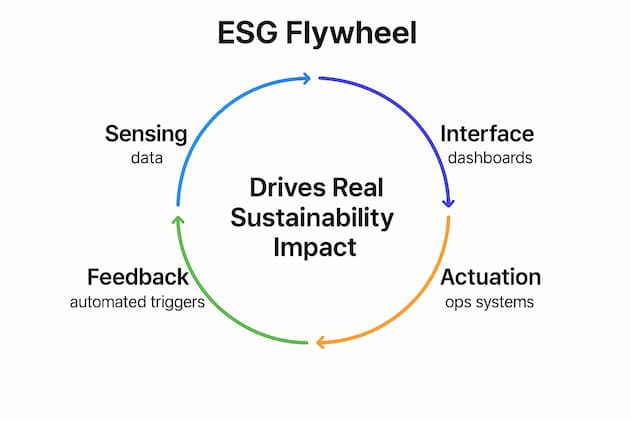The Compliance Bottleneck: Why Most ESG Dashboards Are Useless Without Ops Integration

ESG dashboards have proliferated as organizations seek to monitor and report on their sustainability performance. Yet many of these dashboards exist in isolation from core operational systems, limiting their impact and value. This article explores why operational integration is essential for ESG dashboards to drive meaningful change.
The Current State of ESG Dashboards
Most organizations approach ESG dashboards primarily as reporting tools, designed to:
- Track performance against sustainability targets
- Satisfy disclosure requirements for investors and regulators
- Communicate progress to stakeholders
- Benchmark performance against industry peers
While these functions are important, they represent only a fraction of the potential value ESG dashboards can deliver. The typical implementation process follows a pattern that limits their impact:
- Manual Data Collection: Periodic gathering of sustainability data from disparate sources
- Offline Processing: Calculation and verification in spreadsheets or specialized ESG software
- Dashboard Population: Loading of processed data into visualization tools
- Periodic Review: Quarterly or annual examination of results by sustainability teams
This approach creates several critical limitations:
- Data Latency: Information is often months old by the time it reaches decision-makers
- Functional Silos: ESG insights remain isolated from operational decision-making
- Limited Actionability: Data is too aggregated or too infrequent to drive specific interventions
- Sustainability Disconnect: ESG becomes perceived as a reporting exercise rather than a business imperative
The Integrated ESG Operations Model
A more effective approach integrates ESG dashboards directly with operational systems, creating a continuous flow of sustainability data and insights throughout the organization:
This integrated model transforms ESG dashboards from passive reporting tools to active management systems that:
- Provide Real-Time Visibility: Continuous monitoring of sustainability performance
- Enable Operational Decisions: Actionable insights at the point of decision-making
- Drive Process Improvement: Identification of specific intervention opportunities
- Support Predictive Analytics: Forecasting of sustainability impacts before they occur
Key Elements of Operational Integration
Achieving this integration requires several key elements:
1. Automated Data Flows
Rather than periodic manual collection, sustainability data should flow automatically from operational systems into ESG dashboards. This requires:
- API Connections: Direct interfaces between operational systems and ESG platforms
- IoT Integration: Real-time data from sensors and monitoring devices
- Standardized Data Models: Consistent definitions and formats across systems
- Validation Workflows: Automated quality checks to ensure data integrity
2. Operational Embedding
ESG metrics should be visible within the systems that operational teams use daily:
- ERP Integration: Sustainability data alongside financial and operational metrics
- Process Controls: ESG parameters built into operational procedures
- Decision Support: Sustainability impacts visible at decision points
- Performance Management: ESG metrics included in team and individual objectives
3. Closed-Loop Improvement
The system should enable continuous improvement through:
- Anomaly Detection: Automatic identification of sustainability outliers
- Root Cause Analysis: Tools to diagnose drivers of ESG performance
- Intervention Tracking: Monitoring the impact of sustainability initiatives
- Feedback Mechanisms: Channels for operational teams to provide context and insights
Case Study: Manufacturing Sector Integration
A global manufacturing company transformed its approach to ESG dashboards through operational integration:
Before Integration:
- Quarterly manual collection of energy, water, and waste data
- Sustainability team processing and reporting results
- Executive review of aggregated metrics every six months
- Limited visibility for operational teams into sustainability performance
After Integration:
- Real-time energy, water, and waste data flowing from facility management systems to ESG dashboard
- Production supervisors seeing sustainability metrics alongside productivity and quality in their daily operational dashboards
- Automated alerts when resource consumption deviates from expected levels
- Sustainability impacts included in production planning algorithms
Results included a 17% reduction in energy intensity, 23% decrease in water consumption, and significant improvement in waste diversion rates—all while increasing production volume.
Implementation Challenges
Organizations pursuing operational integration of ESG dashboards typically face several challenges:
1. Technical Complexity
Connecting legacy operational systems with modern ESG platforms often requires custom integration work and data transformation. Organizations should:
- Start with high-value, accessible data sources
- Leverage middleware and integration platforms where appropriate
- Consider phased implementation rather than "big bang" approaches
2. Cross-Functional Alignment
Integration requires collaboration between sustainability, operations, IT, and finance teams that may have different priorities and perspectives. Success factors include:
- Executive sponsorship that spans functional boundaries
- Shared objectives and performance metrics
- Joint project teams with clear decision rights
3. Data Quality and Governance
As ESG data becomes operational, its quality and governance requirements increase substantially:
- Establish clear data ownership and stewardship
- Implement validation rules and quality monitoring
- Develop protocols for handling data gaps and anomalies
Getting Started: A Phased Approach
Organizations can pursue operational integration of ESG dashboards through a phased approach:
Phase 1: Foundation Building
- Map current ESG data flows and identify operational data sources
- Establish common definitions and metrics across functions
- Implement basic automation for high-priority data streams
- Create cross-functional governance structure
Phase 2: Operational Visibility
- Integrate ESG metrics into operational dashboards
- Implement near-real-time data flows for key metrics
- Develop basic anomaly detection and alerting
- Train operational teams on sustainability impacts
Phase 3: Advanced Integration
- Embed ESG parameters in operational decision algorithms
- Implement predictive analytics for sustainability impacts
- Develop closed-loop improvement processes
- Extend integration to supply chain and product lifecycle
Conclusion
ESG dashboards have the potential to be powerful drivers of sustainable business transformation—but only if they move beyond isolated reporting tools to become integrated operational systems. By connecting sustainability data directly with day-to-day operations, organizations can turn ESG insights into tangible business improvements.
The organizations that succeed in this integration will not only achieve better sustainability outcomes but will also discover new sources of efficiency, innovation, and competitive advantage. In an era where ESG performance increasingly influences access to capital, customers, and talent, operational integration of ESG dashboards is becoming a business imperative rather than just a reporting enhancement.